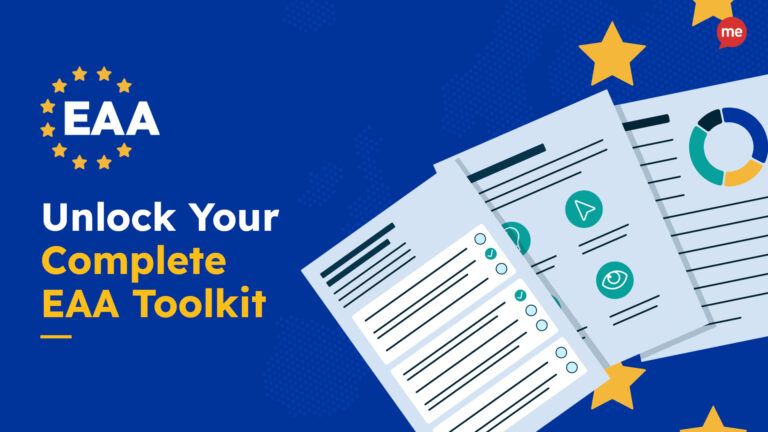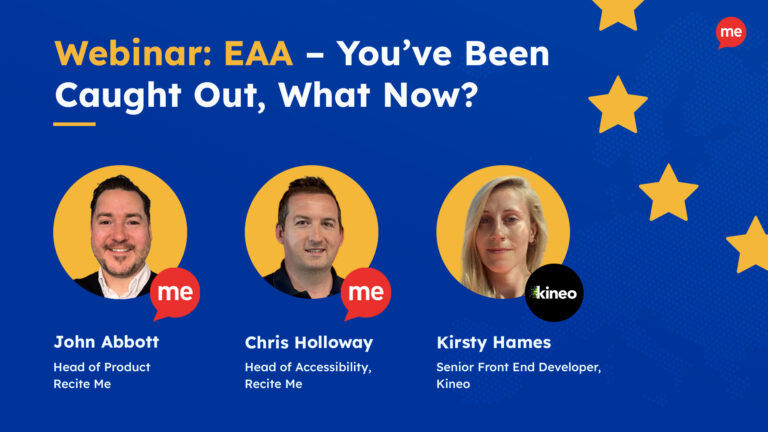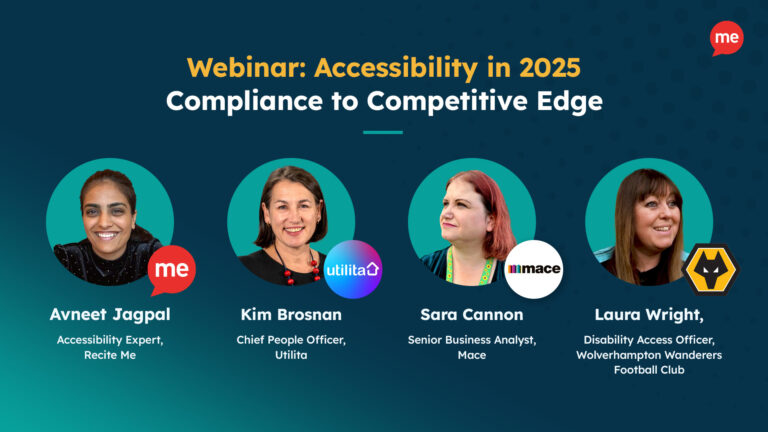Get A Free Accessibility Check Of Your Website
Download NowResearch shows one in five Brits (20%) have a disability. That’s nearly 13.5 million people.

When we hear the word ‘disabled,’ we tend to think of people in wheelchairs and those with mobility issues. Statistics reveal that less than 8% of the disabled population require a wheelchair or mobility assistance. However, there are a range of neurological, cognitive, linguistic, and other hidden disabilities that affect a significant percentage of the population.
Any disability can be problematic when using the internet, as online barriers prevent disabled website visitors from navigating, reading, and understanding the content. That’s why legislation is in place to prevent discrimination based on disability.
UK Web Accessibility Law
A poorly designed website excludes people just as much as steps at the entrance of a physical location would exclude someone in a wheelchair. Web accessibility legislation removes unnecessary online barriers to provide everyone with equal access to information.
The government has prioritised web accessibility in recent years because, in our modern-day society, we rely on the internet more than ever before in many aspects of daily life. There are two critical pieces of UK accessibility legislation to be aware of:
Both pieces of legislation make it illegal to discriminate against disabled people online. Let’s look into each in more detail.
The Equality Act
The Equality Act prohibits discrimination based on disability. The section that relates specifically to website accessibility laws is British Standard BS 8878. Published in 2010, BS 8878 it applies to all web products, including:
- Websites
- Email clients
- Virtual learning environments
- SaaS (Software as a Service)
- RIA (Rich Internet Applications
In 2019, BS 8878 was replaced with the international standard ISO 30071-1. However, this update did little to change the existing recommendations that organisations should:
- Consider accessibility in decision-making processes throughout the development phase of any website.
- Have an established policy for digital accessibility, and document any decisions related to digital accessibility.
- Communicate accessibility decisions and goals clearly by publishing an accessibility statement on their websites.
Accessibility Regulations Vs UK.Gov Accessibility Requirements
In summary, all websites (whether in the various public sector websites or private sector) must complete the following action points to be considered compliant:
- Meet the Web Content Accessibility Guidelines (WCAG) 2.1.
- Publish a compliant accessibility statement. Use our free website accessibility statement generator here.
However, UK.gov websites are required to comply with two further criteria, making a total of four checkpoints to meet the UK.Gov service standard:
- Include disabled users in user research.
- Be tested with common assistive technologies.

The Public Sector Bodies (Websites and Mobile Applications) Accessibility Regulations
While BS 8878 did not specifically mention making mobile apps accessible, it was interpreted as applicable nonetheless. However, the publication of new public sector body regulations in 2018 removed any doubt that mobile apps could be excluded from web accessibility planning in the public sector.
The 2018 regulations incorporated several deadlines that aligned with existing European Standards, stipulating that:
- Websites that were created before 23 September 2018 must be compliant by 23 September 2020
- Websites that were created after 23 September 2018 must be compliant by 23 September 2019
- All mobile applications should be accessible by June 2021
What Problems Do Accessible Websites Solve?
Online barriers come in several forms. Here are some examples of the most common errors that can make a website inaccessible:
- Poor site structure – If a website doesn’t use headers and present information in a logical order, visitors using screen readers can’t scan content to find the information they need.
- Insufficient colour contrasts – When colour pairings have insufficient contrast, or when colour alone is used to provide information, text can be difficult or impossible for visually impaired users to read.
- Lack of descriptive links – Screen readers utilise keyboard shortcuts to list the links on each page to navigate more efficiently. Non-descriptive hyperlink text like ‘click here’ and ‘read more’ do not adequately indicate where the link goes.
- Missing Alt text – Pictures, illustrations, and charts make no sense to visually impaired website visitors when no text alternative is provided to convey their purpose. Learn how to create accessible alt text here.
- Missing captions – When videos don’t have captions, people with hearing disabilities may be unable to understand the information.
- Insufficient keyboard navigation – Some people with disabilities cannot use a mouse or trackpad. Keyboard navigation should allow every interactive element of a web page to be selected using the tab key. Learn more about Keyboard Accessibility here.
- Inaccessible online forms – Online forms represent some of the most complicated interactions a user can have with a website. Accessible forms provide a clear relationship between labels and their corresponding fields and options to extend time limits for form completion.
The Risks of an Inaccessible Website
Making your website accessible is the right thing to do if you’re a uk service provider. However, meeting accessibility requirements in the UK is also the cost-effective thing to do from sales, customer satisfaction, and legal perspectives.
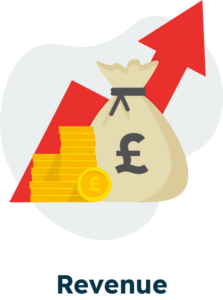


Revenue
If your website isn’t in an accessible format, your organisation misses out on 20% of the potential market share. The spending power of disabled people and their families is worth a staggering £274 billion, and the UK is one of the countries with the highest average e-commerce revenue per shopper, at £1,629 per person per year. Plus, there’s no shortage of statistics that prove that investing in web accessibility upgrades is a wise move:
- 71% of users leave a site that they find hard to use (ClickAway Pound)
- For 81% of users, ease of use is more important than price (ClickAway Pound)
- 82% of consumers with accessibility issues said they would spend more if there were fewer barriers (ClickAway Pound)
Customer Satisfaction
Most organisations know attracting and retaining new customers costs much more than keeping existing ones. Yet, studies reveal that many disabled customers are dissatisfied with current levels of accessibility:
- 73% of disabled customers experience barriers on more than one in four websites they visit (PurplePound)
- 75% of disabled people and their families have walked away from a business because of poor accessibility or customer service (PurplePound)
- 83% of people with access needs limit their shopping to sites that they know are accessible (PurplePound)
Legal Risk
Despite legislative efforts to increase the accessibility requirement and provide online equity, many websites still fail to meet minimum accessibility standards:
- 60% of local authority websites’ home pages still aren’t accessible to people with disabilities (Scope)
- 90% of the county council websites failed to meet regulations (Scope)
- 86% of local authority homepages websites are hard to navigate because they lack visible focus indicators that show where the cursor/ arrow/ focus is (SOCITM’s Better Connected survey)
- 64% of local authority sites do not attribute meaningful descriptions to hyperlinks, making context difficult to establish for people with learning difficulties and cognitive disabilities (SOCITM’s Better Connected survey)
- 49% of local authority webpages have insufficient colour contrast between the text and background, making them impossible to read for people with dyslexia and decreased vision (SOCITM’s Better Connected survey)
While UK-based companies have seen little in the way of legal lash back to date, the tide is turning. A record number of 2,387 website accessibility lawsuits were filed in 2022 in America, and it’s expected that British organisations may soon find themselves facing similar legal action.
Learn more about the equality and in particular the difference between equality and equity here.
Our 40-page Digital Accessibility & Inclusion Toolkit helps businesses break down online barriers and make a real impact. It offers practical advice on all aspects of digital accessibility, from writing an accessibility statement to accessible website tips and inclusive hiring.

WCAG: The Key to Web Accessibility Compliance
Unlike some other international accessibility laws, both the Equality Act and the Public Sector Bodies (Websites and Mobile Applications) Accessibility Regulations explicitly apply to websites. However, neither address technical accessibility standards. Instead, organisations are directed toward the globally international standards provided by the Web Content Accessibility Guidelines (WCAG) 2.1 Level AA.
WCAG were developed to be used by anyone involved in building and maintaining a website, including web developers, content writers, graphic designers, tool developers, accessibility testers, and anyone else seeking to learn or better understand how to implement accessible online journeys.
Why WCAG 2.1 AA?
There are three levels of WCAG compliance that organisations can strive for. Version 2.1 is the most recent, globally accepted version of the guidelines, and Level AA encompasses criteria commonly accepted as the minimum in terms of ‘making a website accessible’. So, if you’re just starting out on your website accessibility journey, you should make changes to align with WCAG 2.1 Level A as soon as possible, but Level AA compliance should be your ultimate aim.
Level AA criteria include more advanced compliance points than Level A (Level AA compliance list comprises 50 checkpoints, and Level A only 30). Plus, getting your website up to WCAG 2.1 AA level means you’ll check all the criteria listed in The Equality Act 2010 and The Public Sector Bodies (Websites and Mobile Applications) Accessibility Regulations of 2018.
Web Accessibility Compliance Made Easy
The Recite Me Accessibility Checker is changing the way organisations address legislative compliance issues on their websites. Whether your organisation is a private company, public body, or charity, our goal is to simplify the process of fixing non-compliant components and provide you with the expert knowledge you need to continue your website accessibility journey and help you succeed in your organisational goals.
Introducing the Recite Me Checker
The Recite Me Checker audits back-end and front-end web development processes by running 390 separate compliance scans in line with WCAG 2.1 and breaking down the issues you should be working to fix, track, and share.
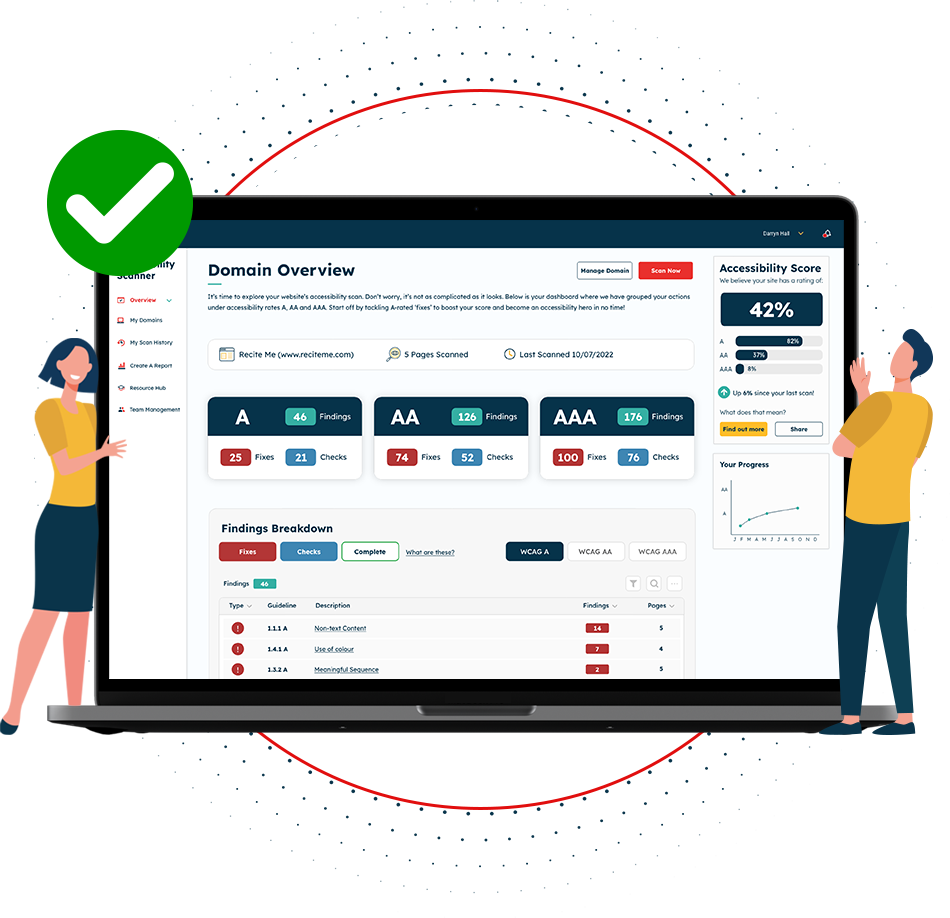
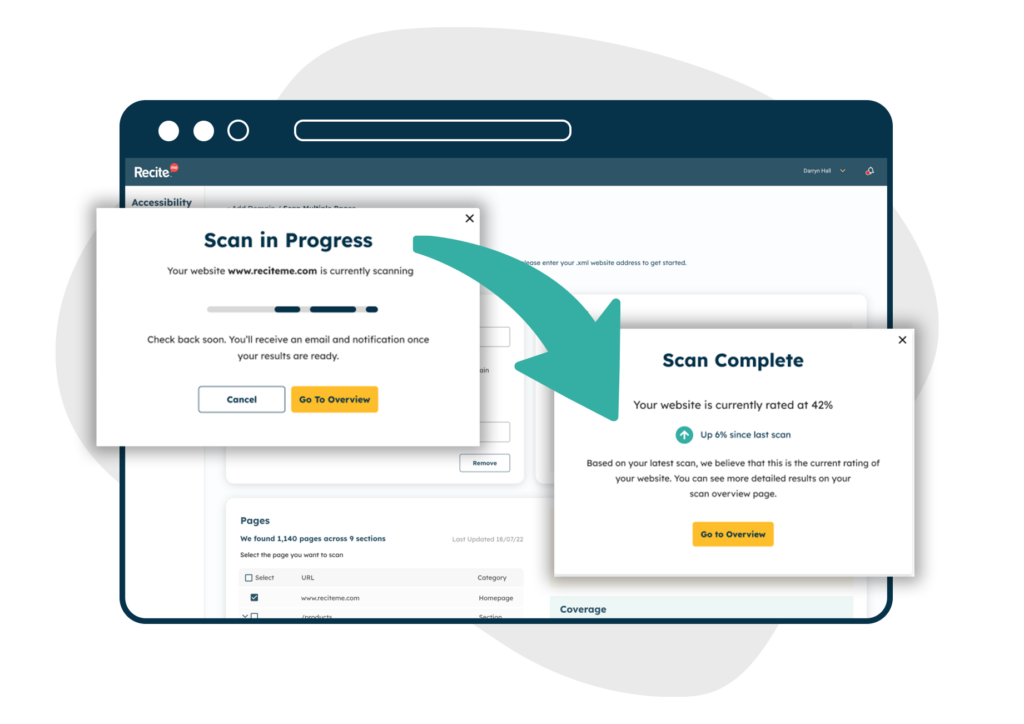
Scan
Your accessibility journey starts here with a scan of your website covering WCAG 2.1 success criteria encompassing:
- Site performance overview
- Accessibility scoring
- Findings per rating
- Error breakdown
The scan report includes an overview of errors, the locations of errors, and a comprehensive list of actionable errors to fix and check.
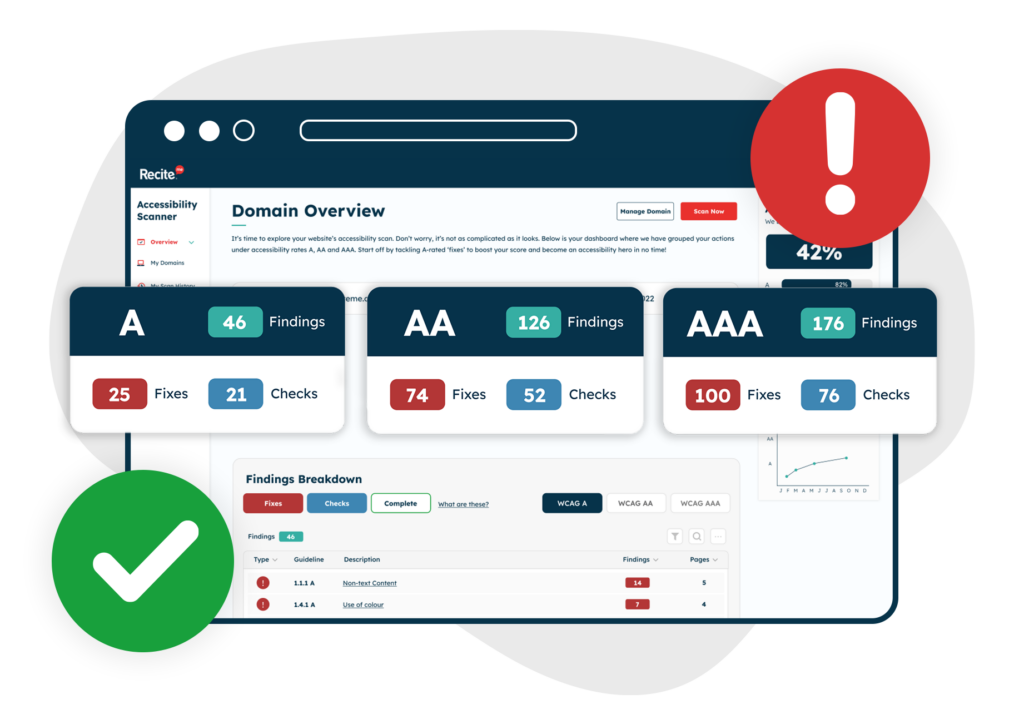
Fix and Check
Our software identifies areas of non-compliance and shows you what to fix and check and in what order for the biggest improvement against your efforts, investment, and time. Fixes are confirmed fails identified via an automated scan and checks are potential errors that a human needs to verify. For example, a computer can identify if an image on a website has an alt-tag attribute or not. However, human eye is needed to make sure that the alt tag text describes the image.
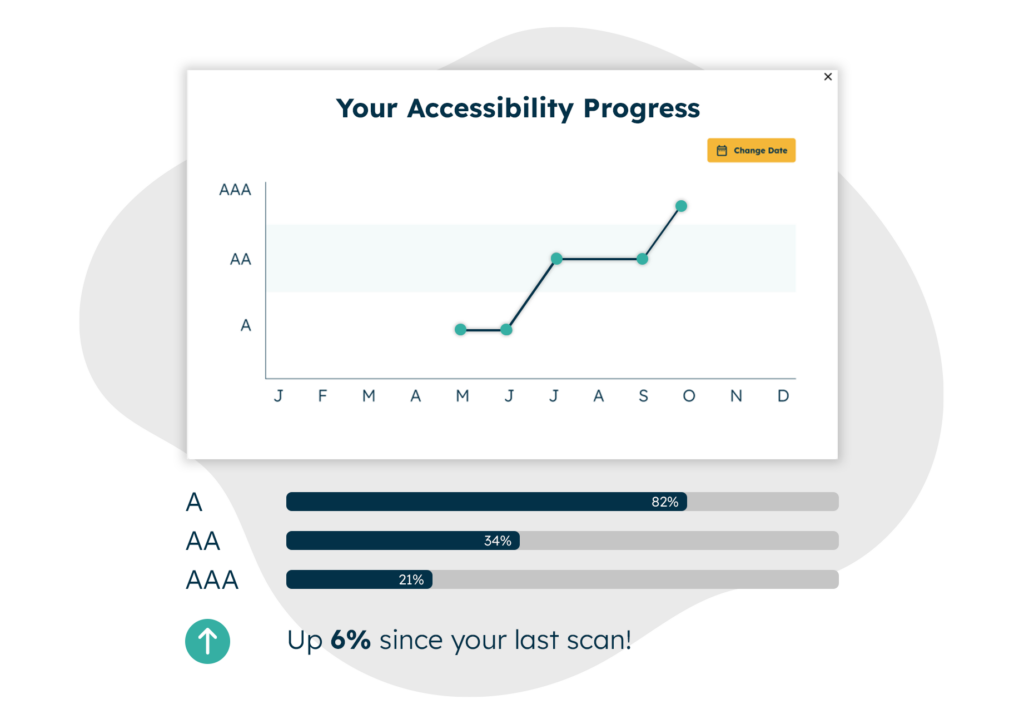
Track
Our compliance tracking service helps you manage your web accessibility improvements over time, make the most effective changes in the right order, and manage your fix queue. You can examine various elements of WCAG compliance by exploring different scans and download your website’s scan accessibility score and report to track your positive journey.
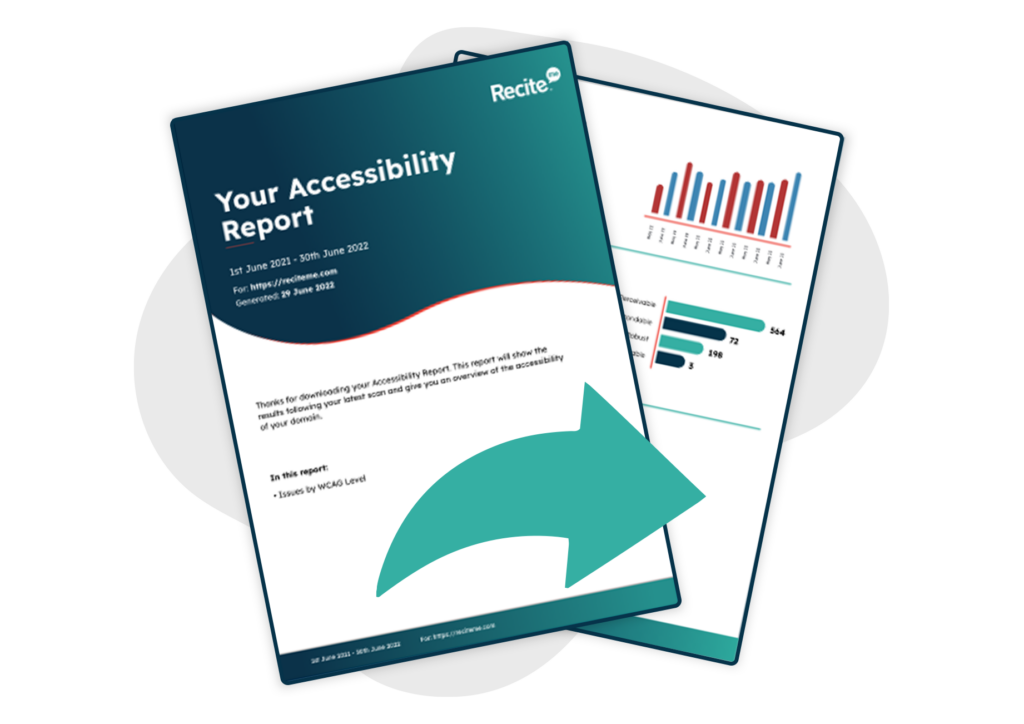
Share
We give you all of the tools needed to demonstrate your commitment to developing an accessible website. You can share your accessibility report and score to showcase your digital inclusion goals and achievements via:
- Custom monthly reporting
- Ongoing engagement analysis
- Accessibility scoring
- Downloadable fix lists
- Access to the Recite Me Hub which features materials highlighting the depth of information behind your website’s scan and results. Resources include FAQs, full breakdowns of testing methodologies, and ‘how to’ videos.
Start Your Web Accessibility Compliance Journey Today
Online accessibility is a journey, not a destination. Recite Me is here to help you every step of the way to provide an inclusive and compliant website. We save you time and money by highlighting what needs fixing first for most effective results and the most significant return on investment.
Get to work on your online inclusion strategy today by running a free check of your website for WCAG 2.1AA compliance.


